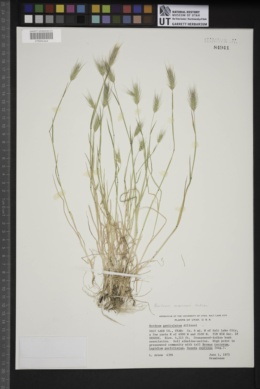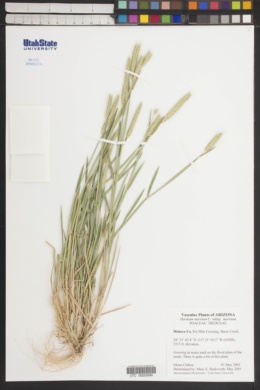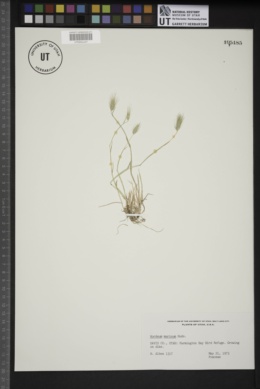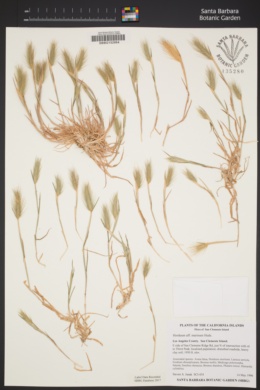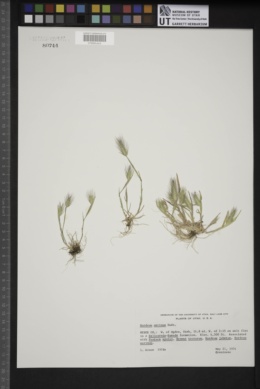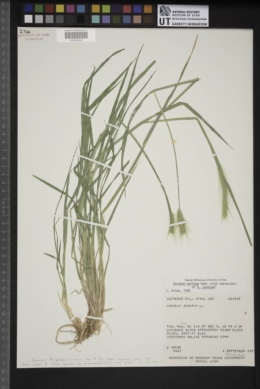Hordeum marinum
|
|
|
|
Family: Poaceae
Seaside Barley, more...Sea Barley
[Hordeum marinum subsp. marinum Huds., moreHordeum maritimum Stokes ex With.] |
Plants annual; loosely tufted. Culms to 50 cm, straight to geniculate; nodes glabrous. Basal sheaths somewhat hairy; ligules 0.2-0.5 mm; auricles usually absent or to 0.3 mm; blades to 8 cm long, 1-6 mm wide, sparsely to densely hairy on both sides. Spikes 1.5-7 cm long, 5-10(20) mm wide, dense, green or more or less purplish on the awns and glumes; rachises disarticulating at maturity, triplets not breaking up immediately after maturity. Glumes straight, ascending to slightly divergent at maturity. Central spikelets: glumes 14-26 mm long, 0.2-1.1 mm wide basally, setaceous distally; lemmas 5-8 mm, usually smooth or somewhat scabrous, sometimes pubescent, awned, awns 6-18 mm; anthers 0.8-1.3 mm, yellowish. Lateral spikelets sterile; lower glumes setaceous or winged, wings 0.5-2.3 mm wide; upper glumes setaceous; lemmas 4-6 mm, awned, awns 3-8 mm. 2n = 14, 28. Hordeum marinum is native to Eurasia, where it grows in disturbed habitats. It has become established in similar habitats in western North America, and in scattered locations elsewhere. Two subspecies are recognized; both are found in the Flora region. ©Utah State University. Reproduced by permission. POST PUBLICATION AMENDMENT Jakob et al. (2007) recommend that the two subspecies of Hordeum marinum should be restored to specific status as Hordeum marinum =subsp. marinum] and Hordeum geniculatum All. [=Hordeum marinum subsp. gussonaenum]. The key to subspecies will sort the two taxa out pending posting of a revised key to Hordeum. Barkworth, 2017.
Plants summer or winter annuals. Leaves 1.5-8 mm wide, usually flat. Lateral spikelets: lower glumes winged on the side towards the central spikelets, wings 0.5-2.3 mm wide. 2n = 14. Hordeum marinum subsp. marinum is native to Eurasia, where it grows in disturbed habitats. Although it has been reported occasionally from the Flora region, it has not become established. POST PUBLICATION AMENDMENT Jakob at el al. 2007 recommend treating the two subspecies of Hordeum marinum as species. Following that recommendation, Hordeum marinum subsp. marinum should be called Hordeum marinum. FNA 2003, Gould 1980 Common Name: seaside barley Duration: Annual Nativity: Non-Native Lifeform: Graminoid General: Loosely tufted annual with straight to geniculate stems to 50 cm, glabrous nodes with somewhat hairy basal sheaths. Vegetative: Blades to 8 cm long, 1-6 mm wide, sparsely to densely hairy on both sides; ligule less than 0.5 mm, with no auricles, or minute. Inflorescence: Spikes 1.5-7 cm long, 5-10 mm wide, ovate to ovate oblong, well exserted or partially retained within the sheath, dense, green to purplish on awns and glumes; glumes straight, ascending to slightly divergent at maturity; rachises disarticulating at maturity, triplets not breaking up immediately after maturity; central spikelets with glumes 14-26 mm long, setaceous above; lemmas 5-8 mm, smooth to somewhat scabrous, sometimes pubescent, awned, awns 6-18 mm; lateral spikelets sterile. Ecology: Found in disturbed area, widespread; flowers summer. Notes: Pay attention to the lack of auricles to distinguish from Hordeum murinum complex. Ours is ssp. gussoneanum, which is distinguished by being summer annuals with leaves 1.5-4 mm wide, flat to involute, the lateral spikelets have lower glumes that are usually setaceous, a little widened but not winged. Ethnobotany: Used for fodder when green. Etymology: Hordeum is the Latin name for barley, while marinum means of or growing by the sea. Synonyms: Many, see Tropicos Editor: SBuckley, 2010 |






















































































